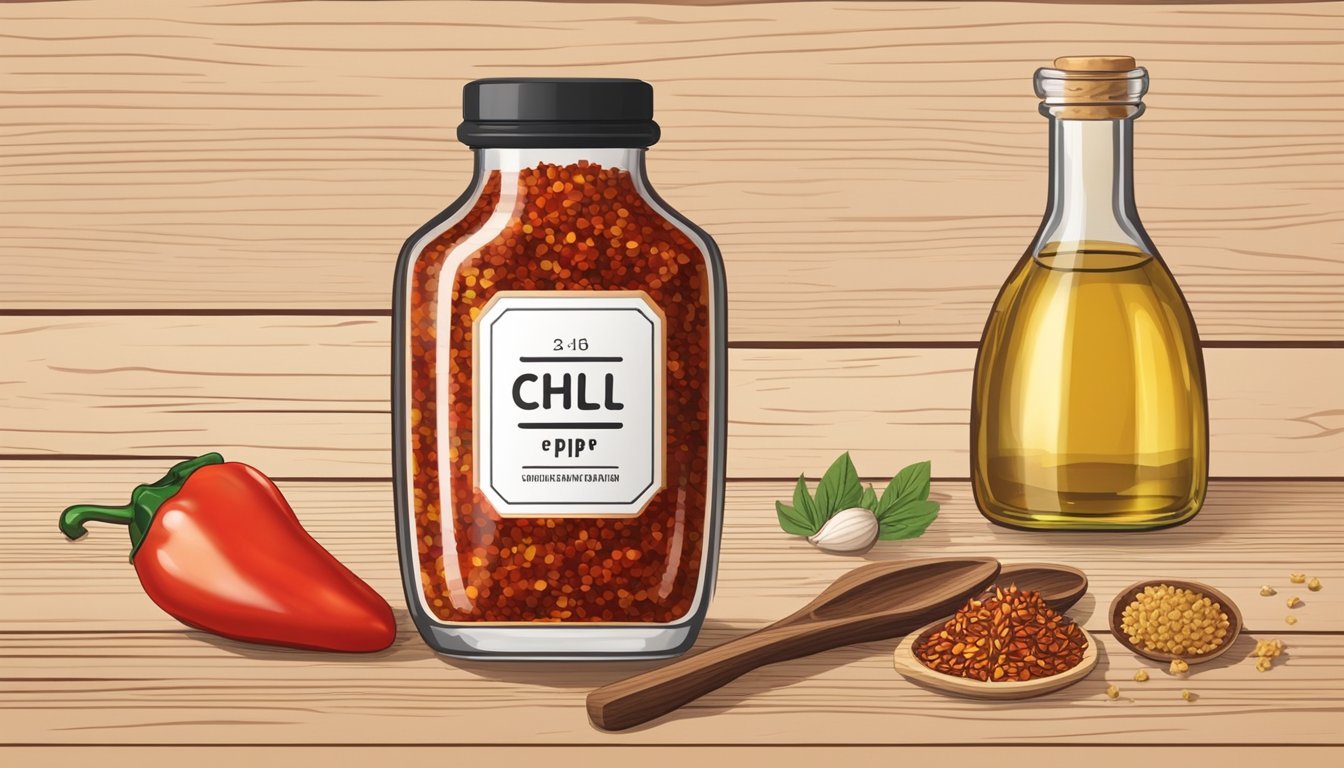Chili Oil Substitutes
Top Flavorful Alternatives for Heat Seekers
Chili oil is a staple in various cuisines, offering a spicy kick that enhances the flavor of numerous dishes. Its unique taste comes from infusing oil with chili peppers, often complemented with additional ingredients such as garlic, salt, and sesame seeds. For those who find themselves without chili oil or prefer a different level of heat or flavor profile, there are several substitutes that can be employed to achieve a similar effect in recipes.
A straightforward substitute is cayenne pepper, which provides a comparable heat and can be mixed with a neutral oil to mimic the consistency of chili oil. Sriracha sauce, while thicker, is another popular alternative, sharing a similar flavor palette due to its ingredients that include chili peppers, garlic, and vinegar. Other options like chili garlic sauce or even a simple shake of red pepper flakes into oil can also stand in for chili oil, ensuring that dishes still receive that desired spicy element. Each alternative offers a unique twist to the original flavor, allowing for customization according to personal taste preferences and the requirements of the recipe at hand.
Understanding Chili Oil
Chili oil, a condiment staple in various cuisines, is recognized for its ability to infuse dishes with a warm, spicy flavor. It plays a dual role as a flavor enhancer and a source of health benefits due to its components.
Composition of Chili Oil
Chili oil is typically made by infusing oil, such as vegetable, soybean, or sesame oil, with chili peppers. This combination often includes additional spices like Sichuan pepper, garlic, and sometimes other seasonings to add complexity. Here's a breakdown of the primary components:
Oil base: Usually a neutral oil that carries the heat and flavors.
Chili peppers: The source of the oil's heat and a rich, red color.
Garlic: Adds depth and complements the sharpness of the chili.
Spices: May include Sichuan pepper for a characteristic tingle and various other spices for layers of flavor.
This rich mixture is left to infuse until the oil absorbs the heat, color, and rich umami flavor of the ingredients.
Culinary Uses of Chili Oil
Chili oil is a versatile condiment used across multiple culinary applications. It can serve as a finishing touch, a cooking ingredient, or a marinade base. Some specific uses include:
Dressings: Enhances salads with a spicy kick.
Noodle dishes: Gives a flavorful heat to Asian cuisines.
Pizza and pasta: Offers a quick way to spice up Italian foods.
Dipping sauces: Adds a flavorful component to dips and sauces.
The oil's ability to impart a distinctive heat and taste to a wide array of dishes makes it a kitchen essential.
Health Benefits
Chili oil isn't just about flavor; it offers health promoting properties as well. The antioxidants in chili peppers are known for their potential to combat oxidative stress. Key health points include:
Antioxidants: Chili peppers contain compounds like capsaicin which are thought to have antioxidant properties.
Flavor without guilt: Adds a burst of flavor to food without significant calories.
While chili oil can contribute to a healthy diet, one should consume it in moderation due to its high fat content and the intensity of its flavors.
Substitutes for Chili Oil
When a recipe calls for chili oil and it's not on hand, several effective substitutes can provide a similar heat and flavor profile. Whether the preference is for an oil-based alternative or something on the pantry shelf, a satisfactory option can be found.
Oil-Based Substitutes
For preparations needing the oiliness of chili oil, there are several oils that can be infused with heat:
Olive Oil: A robust oil that can be heated with crushed chilies or chili flakes to achieve the desired spice level.
Sesame Oil: It provides a nutty flavor along with spice when infused with chilies.
Sunflower Oil and Peanut Oil: Both being neutral oils, they can be heated with chili peppers to make a close mimic.
Vegetable Oil: Its neutral taste makes it a versatile base for heating with chilies.
Avocado Oil: With a high smoke point, it's ideal for infusing with chili peppers over heat for a milder spice effect.
Non-Oil-Based Substitutes
Not all substitutes need to be oil-based. Here are alternatives that still add a punch without the oily texture:
Sriracha Sauce: This sauce combines chilies, garlic, and vinegar, offering a liquid substitute with a texture more akin to sauces.
Hot Sauces (e.g., Tabasco): Generally available, these sauces add heat in a few drops, providing spice and additional flavors.
Homemade Alternatives
Creating a custom chili oil substitute allows control over flavor and spice. Here are some simple combos:
Cayenne Pepper + Neutral Oil: A mix of cayenne pepper and a chosen oil (like sunflower or vegetable oil) can be customized for heat intensity. A good starting ratio is one teaspoon of cayenne to one tablespoon of oil.
Garlic-Infused Oil: Infuse olive or vegetable oil with garlic for a savory base, then add chili flakes or powder to taste, mixing well for even flavor distribution.
Chili Oil in Recipes
Chili oil is a flavorful component in various dishes across different cuisines, known to enhance recipes like noodles, rice, marinades, sauces, stir-fries, soups, stews, and even pizza or pasta with its unique heat and aroma.
Adjusting the Heat Level
When incorporating chili oil into recipes, the level of heat is crucial. Cooks should consider the desired spiciness of the final dish, as chili oil can vary in intensity. For a milder flavor, one can dilute the oil with a neutral carrier like vegetable oil, while for a stronger heat, it's best to use the chili oil in its pure form or even infuse it with additional chili peppers.
Consider the following heat level adjustments:
Mild: Mix 1 part chili oil with 2 parts neutral oil.
Medium: Use chili oil as directed in the original recipe.
Spicy: Add extra chili flakes or peppers to the oil for an intense kick.
Determining the Right Substitute
Choosing a substitute for chili oil depends on what aspect of the oil one wishes to replicate—heat, flavor, or texture.
Heat: Cayenne pepper mixed with oil can replicate the heat of chili oil. For a 1 tablespoon serving, use the following mix:
Cayenne Pepper Olive Oil (or other neutral oils) 1 teaspoon 1 tablespoon
Flavor: Sriracha sauce maintains a similar flavor profile to chili oil, characterized by chili peppers, garlic, and a touch of sweetness. It is thicker in consistency but can be thinned out if necessary.
Texture: To match the texture of chili oil without significantly altering flavor, a mix of crushed red pepper flakes in a neutral oil like canola oil can serve as an appropriate substitute. Use a 1:1 ratio to the chili oil called for in recipes like stir-fries or marinades.
Flavor Profile Considerations
When seeking substitutes for chili oil, one must consider both the level of heat and the complex aromatics inherent to the original ingredient. The objective is to maintain the integrity of the dish's flavor profile while using alternative components.
Matching the Spiciness
Chili oil's primary attribute is its spicy flavor, which can range from a mild warmth to an intense heat, depending on the type of chili used. For cooks looking to match the heat component, cayenne pepper mixed with a neutral oil provides a similar spicy kick. The ratio recommended is 1 teaspoon of cayenne pepper to 1 tablespoon of oil. This combination can be adjusted based on personal heat tolerance.
Another aspect to consider is the potential to create a more nuanced spiciness. For example, one could combine:
Smoky: Chipotle in adobo sauce can replace part of the needed oil for a smoky undertone.
Sweet and spicy: A sweeter chili, like ancho, can provide a less aggressive heat while adding a subtle sweetness.
Replicating the Aromatics
Beyond heat, chili oil contains aromatic elements that contribute to its unique taste profile. One should consider including herbs and spices like cumin, rosemary, or thyme if the recipe allows. For instance, cumin can provide a similar depth and earthiness to a dish as chili oil.
To replicate the aromatic complexities, one might try:
Herbs: A pinch of rosemary or thyme could be infused into the oil to add an aromatic touch.
Toasted Sesame Oil: For a deep umami flavor that echoes what chili oil might contribute, toasted sesame oil is an excellent option.
The goal is to ensure that the substitute not only brings a desirable level of heat to the dish but also resonates with the intricate aromatic notes chili oil imparts.
Specialty Substitutes
When seeking suitable chili oil replacements within specific genres of cooking, particularly Asian cuisine, the focus shifts to alternatives that maintain the integrity of a dish's flavor profile. Two notable categories to explore are Asian Cuisine Alternatives and Unique Regional Variants, where precise substitutes can be found for distinctive, region-specific dishes.
Asian Cuisine Alternatives
For lovers of Asian cuisine, finding a chili oil substitute that complements the dish’s original essence is essential.
Gochujang: This Korean chili paste blends chili powder, fermented soybeans, and glutinous rice, offering both heat and a unique umami flavor.
Sambal Oelek: A ground chili paste used in Indonesian cooking, it provides a simple yet robust chili flavor and can be combined with oil for a closer chili oil consistency.
Chili Garlic Oil: Frequently found in Chinese cuisine, this is an already prepared mixture similar to chili oil but with added garlic notes.
Black Bean Sauce: While not spicy on its own, when mixed with Sichuan peppercorns, it introduces a complex, slightly fermented taste and a hint of heat.
Sichuan Sauce: This incorporates Sichuan peppercorns known for their numbing spice, which is a key component in many Sichuan dishes.
Unique Regional Variants
Exploring regional variants exposes one to unique flavors and textures that are geographically specific.
Chiu Chow Chili Oil: Originating from the Chaozhou region of China, it includes chili flakes, garlic, and roasted sesame oil, exuding a distinct aroma and taste.
Salsa Macha: A less conventional substitute, this Mexican chili oil includes a diverse range of spices and seeds, often bolstered by the presence of nuts for an intricate flavor mosaic.
Incorporating these substitutes into dishes can preserve the culinary characteristics of the original cuisine, confidently providing the intended experience and maintaining authenticity.
Substitute Application
In applying chili oil substitutes, one must consider the cooking context and desired flavor profile. Substitutes can vary in potency, additional flavors, and texture.
Sauces and Marinades
For sauces and marinades, substitutes should complement other ingredients without overwhelming them. Sweet chili sauce is often a preferred alternative in sauces due to its balanced heat and sweetness. When seeking a tang with less viscosity, soy sauce mixed with a touch of a heat source, such as Tabasco, can provide depth to both dipping sauces and marinades. The usage of sambal oelek, with its chunkier texture, is ideal for marinades, offering a milder heat and a hint of acidity, which tenderizes and infuses meats effectively.
Dipping Sauces: To prepare a dipping sauce, mix a heat element like Tabasco into a neutral base, such as a soy or teriyaki sauce, balancing the spiciness according to preference.
Marinades: Combine sambal oelek with ingredients like garlic, sesame oil, and a sweetener to create a dynamic and flavorful marinade.
Cooking and Frying
When cooking and frying, it’s imperative to have a substitute that can withstand heat and disperse flavor evenly. For high-temperature cooking, a blend of neutral oils, like peanut or canola, with ground cayenne pepper can mimic chili oil's heat without altering the dish’s intended flavor significantly. These substitutes should be added in moderation to avoid overpowering the dish.
Cooking: Use a small amount of cayenne pepper mixed in a high smoke point oil to avoid burning, allowing the spice to infuse gradually during the cooking process.
Frying: When frying, one can create a spiced oil by heating the substitute directly in the pan before adding other ingredients, ensuring an even distribution of the spicy notes.
Substitutes should be used based on their flavor contributions and how well they integrate into the existing recipe framework.
Shopping for Substitutes
When one is seeking alternatives to chili oil, the key is finding ingredients that offer a similar heat profile and aroma. Here's how shoppers can identify suitable substitutes to meet their culinary needs.
Finding the Right Ingredients
Cayenne Pepper: A classic choice, cayenne pepper provides a strong, spicy kick without the complexity of additional flavors. It is readily available in most stores, and can be used in various forms such as ground powder, flakes, or even fresh peppers.
Sriracha: This widely popular sauce, made from a base of chili peppers, garlic cloves, vinegar, sugar, and salt, rivals chili oil in terms of heat and is an easy-to-find alternative that imparts a tangy, slightly sweet flavor.
Jalapeño: Fresh or pickled jalapeños offer a milder heat that can be suitable for those who prefer less spicy tastes. They can be pureed with oil to approximate the texture and heat of chili oil.
Guajillo: For those looking for a deeper, smokier substitute, guajillo chili can be an excellent choice. Dried guajillo peppers can be rehydrated and blended with oil to create a substitute with mild to moderate spiciness and a hint of fruitiness.
Considerations for Dietary Restrictions
When selecting substitutes for chili oil, it's important to scrutinize ingredient labels for potential allergens or dietary conflicts. For instance, some sriracha sauces contain fish sauce or preservatives that may not be suitable for all dietary needs. Similarly, individuals with sensitivities to garlic should be cautious with sriracha and garlic-infused substitutes. When creating a homemade mixture, such as blending cayenne pepper with oil, one has the advantage of controlling the ingredients to ensure they align with dietary restrictions and preferences.
Nutritional Aspects
When considering different chili oil substitutes from a nutritional standpoint, it's important to evaluate their composition in terms of macronutrients and micronutrients. Substitutes such as hot sauces often contain various ingredients including salt, sugar, vinegar, and occasionally small amounts of protein.
Salt: Substitutes like hot sauce or chili garlic sauce typically have higher sodium content. This is important for individuals monitoring their salt intake.
Sugar: Many chili oil substitutes can contain added sugars for flavor balance. Reading labels is essential for those managing sugar consumption.
Vinegar: A common ingredient in hot sauces and substitutes, vinegar provides tanginess but negligible nutritional value.
Protein: While chili oil and its substitutes are not significant sources of protein, some alternatives may contain minimal amounts from added ingredients like garlic.
Iron: Depending on the specific chili used and its concentration, there could be trace amounts of iron in the substitutes.
For individuals concerned about specific dietary requirements, here's what they should consider:
Nutrient Consideration Salt Choose substitutes with low or no added salt. Sugar Opt for sugar-free options. Vinegar Generally not a nutritional concern unless considering acidity. Protein Protein content is not significantly affected by these substitutions. Iron Look for substitutes using chilies with higher iron content.
It's important for consumers to review nutritional labels to make informed decisions that align with their dietary needs.
Making the Best Choice
When selecting a chili oil substitute, versatility and flavor are key considerations. For those who relish the flavor of spicy food but need an alternative, Sriracha is a prominent choice due to its similar composition. It's bold, garlicky, and delivers a tangy kick, making it a well-rounded addition.
Alternatively, cayenne pepper stands out for its pure heat. It can be blended with olive oil to match chili oil's liquid consistency. This combination not only imparts a spicy flair but also maintains the intensity that chili oil lovers seek.
Cayenne Pepper + Olive Oil: Mix to emulate chili oil's consistency and heat
Sesame Oil: Adds a unique flavor with a lower heat profile
While sesame oil lacks the punch of traditional chili oils, its aromatic nuttiness offers a unique flavor that complements stir-fries and other dishes. This oil should be used sparingly as its flavor is potent.
For those focused on preserving a dish’s authentic spiciness, hot sauces such as Tabasco can be used. They provide a quick and convenient way to inject heat.
Substitute Flavor Note Heat Level Sriracha Garlicky and tangy Medium-High Cayenne + Oil Pure spicy Customizable Sesame Oil Aromatic and nutty Mild Hot Sauce (various) Depends on brand Varies
Each substitute has its own merit and should be chosen based on the desired outcome in flavor and heat intensity. No matter the selection, each provides a way to tailor the piquancy to one's personal preference.









